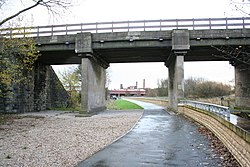
A bridge is a structure built to span a physical obstacle without blocking the way underneath. It is constructed for the purpose of providing passage over the obstacle, which is usually something that is otherwise difficult or impossible to cross. There are many different designs of bridges, each serving a particular purpose and applicable to different situations. Designs of bridges vary depending on factors such as the function of the bridge, the nature of the terrain where the bridge is constructed and anchored, the material used to make it, and the funds available to build it.

Eugène Freyssinet was a French structural and civil engineer. He was the major pioneer of prestressed concrete.

Prestressed concrete is a form of concrete used in construction. It is substantially "prestressed" (compressed) during production, in a manner that strengthens it against tensile forces which will exist when in service.
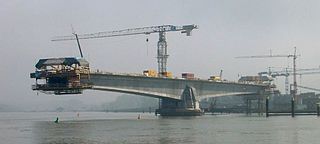
A cantilever bridge is a bridge built using structures that project horizontally into space, supported on only one end. For small footbridges, the cantilevers may be simple beams; however, large cantilever bridges designed to handle road or rail traffic use trusses built from structural steel, or box girders built from prestressed concrete.

A trestle bridge is a bridge composed of a number of short spans supported by closely spaced frames. A trestle is a rigid frame used as a support, historically a tripod used to support a stool or a pair of isosceles triangles joined at their apices by a plank or beam such as the support structure for a trestle table. Each supporting frame is a bent. A trestle differs from a viaduct in that viaducts have towers that support much longer spans and typically have a higher elevation.

The Liverpool and Bury Railway was formed in 1845 and opened on 28 November 1848. The line ran from Liverpool Exchange first using a joint line with Liverpool, Ormskirk and Preston Railway before branching off to proceed via Kirkby then Wigan and Bolton to Bury.

The Helena River is a tributary of the Swan River in Western Australia. The river rises in country east of Mount Dale and flows north-west to Mundaring Weir, where it is dammed. It then flows west until it reaches the Darling Scarp.

The Narrows Bridge is a freeway and railway crossing of the Swan River in Perth, Western Australia.

Strelasund Crossing is the two links to the German island of Rügen (Rugia) over the Strelasund to the West Pomeranian mainland near Stralsund: the Rügen Bridge or Rugia Bridge and the Rugia Causeway.

Precast concrete is a construction product produced by casting concrete in a reusable mold or "form" which is then cured in a controlled environment, transported to the construction site and maneuvered into place; examples include precast beams, and wall panels for tilt up construction. In contrast, cast-in-place concrete is poured into site-specific forms and cured on site.

Christian Menn was a renowned Swiss civil engineer and bridge designer. He was involved in the construction of around 100 bridges worldwide, but the focus of his work was in eastern Switzerland, especially in canton Graubünden. He continued the tradition of and had a decisive influence on Swiss bridge building. The technical and aesthetic possibilities of prestressed concrete were most fully realized with his bridges in Switzerland.
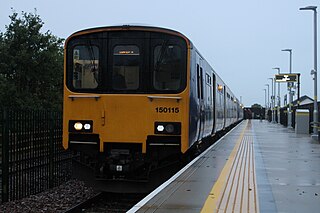
The Kirkby Branch Line is a branch railway line from Wigan to Headbolt Lane. The line's original route was from Liverpool to Bury and later the most northern of the Liverpool to Manchester lines. The line was split at Kirkby in 1977 with the western section forming a high frequency branch of the electrified Merseyrail Northern Line, also referred to as the Kirkby branch line. The Kirkby branch to Wigan remained a low frequency diesel operated service by Northern Trains from Headbolt Lane to Manchester.
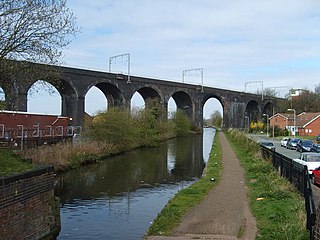
William Baker was an English railway engineer.
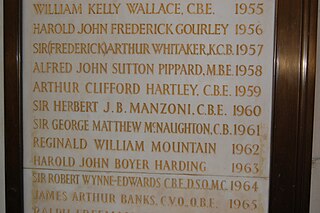
William Kelly Wallace CBE (1883–1969) was an Irish railway engineer who joined the Northern Counties Committee and later became Chief Civil Engineer of the London Midland and Scottish Railway (LMS). He was awarded a civil CBE in the 1946 New Year Honours.

The Northam Bridge is a road bridge across the River Itchen in Southampton, England, linking the suburbs of Northam and Bitterne Manor. The current bridge was the first major prestressed concrete road bridge to be built in the United Kingdom. The bridge carries the A3024 road as a dual carriageway, with two lanes on each carriageway.

The Langwieser Viaduct is a single track reinforced concrete railway bridge spanning the Plessur River and the Sapünerbach, near Langwies, in the Canton of Graubünden, Switzerland.

A double tee or double-T beam is a load-bearing structure that resembles two T-beams connected to each other side by side. The strong bond of the flange and the two webs creates a structure that is capable of withstanding high loads while having a long span. The typical sizes of double tees are up to 15 feet (4.6 m) for flange width, up to 5 feet (1.5 m) for web depth, and up to 80 feet (24 m) or more for span length. Double tees are pre-manufactured from prestressed concrete which allows construction time to be shortened.

The Long Key Bridge, officially known as the Dante B. Fascell Bridge, is a bridge in the Florida Keys connecting Long Key and Conch Key, roughly halfway between Miami and Key West. At a length of nearly two and a half miles, it is the second longest bridge on the Overseas Highway after the Seven Mile Bridge. The current bridge opened in 1982, replacing the parallel Long Key Viaduct, which carried the Overseas Railroad from 1907 to 1935 and was repurposed for highway use shortly after.

The Makatote Viaduct takes the North Island Main Trunk railway (NIMT) across the Makatote River in New Zealand. It is 335.7 km (208.6 mi) from Wellington, at the foot of Ruapehu, in northern Manawatū-Whanganui, between Erua and Pokaka.

Gathurst Viaduct carries the M6 motorway across the Douglas valley at Shevington, Wigan, Greater Manchester, England.
